Fashion & Textile History Gallery
December 3, 2013 – April 30, 2014
<< Online Exhibition >>
Join the conversation on Twitter with hashtag #trendology!
Fashion trends are constantly changing. A single shift in print, color, material,
embellishment, or silhouette may quickly become a major new trend. Yet while the contemporary
fashion press tirelessly reports the latest trend news, it offers scant insight into
where trends originate. Utilizing 100 objects from the museum’s permanent collection,
Trend-ology examines the diverse sources from which fashion trends have emerged over the past
250 years, including urban street style, art, music, film, and socio-political movements.
The exhibition also highlights industry developments that have had an impact on how
trends spread.
The exhibition opens with an overview of 21st-century developments in fashion retailing. This includes examples from concept stores such as Opening Ceremony and Colette, as well as high-low collaborations, such as a “Rodarte for Target” sequined dress from 2009. A selection of “It” bags are also on display to illustrate the importance accessories have become to luxury brands. A Louis Vuitton “Speedy 30” bag designed in collaboration with Japanese artist Takashi Murakami is one example.
The exhibition opens with an overview of 21st-century developments in fashion retailing. This includes examples from concept stores such as Opening Ceremony and Colette, as well as high-low collaborations, such as a “Rodarte for Target” sequined dress from 2009. A selection of “It” bags are also on display to illustrate the importance accessories have become to luxury brands. A Louis Vuitton “Speedy 30” bag designed in collaboration with Japanese artist Takashi Murakami is one example.
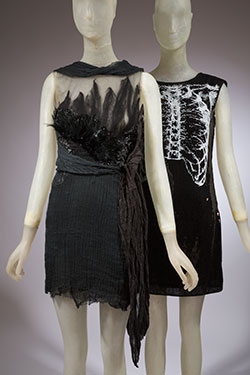
(left) Rodarte, evening dress, black and nude net, wool, leather, beads, cheese cloth,
and metal gauze, spring 2010, USA, Museum purchase.
(right) Rodarte for Target, evening dress, polyester crepe chiffon, 2009, USA, gift of The Fashion and Textile Studies Department and the School of Graduate Studies.
(right) Rodarte for Target, evening dress, polyester crepe chiffon, 2009, USA, gift of The Fashion and Textile Studies Department and the School of Graduate Studies.
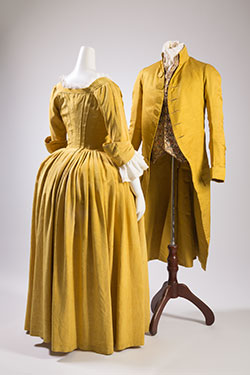
Dress, yellow silk faille, c. 1770, USA (possibly), Museum purchase.
(right) Men’s coat, yellow silk, c. 1790, USA (possibly), Museum purchase.
(right) Men’s coat, yellow silk, c. 1790, USA (possibly), Museum purchase.
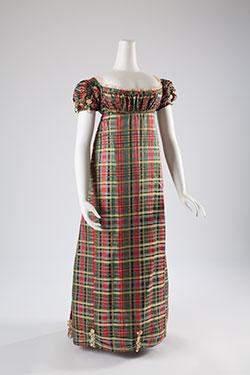
Dress, tartan silk, c. 1812, Scotland, Museum purchase
The exhibition’s historical chronology begins with a pair of 18th-century ensembles
that illustrate how the color yellow, once negatively associated with “heretics,”
became a trend in 18th-century dress. This was related to the growing popularity of
Chinoiserie in Europe. In China, yellow was an auspicious color associated with the Emperor.
The industrial revolution of the 19th century led to certain capitalist developments that altered the ways trends propagate. The department store, for example, offered clients one-stop shopping for a a variety of goods at a faster turnover rate of stock than ever before, thus speeding up the pace of the trend cycle. Also, through the innovation of mail-order catalogs, department stores began marketing trendy items to a wider demographic of consumers.
The industrial revolution of the 19th century led to certain capitalist developments that altered the ways trends propagate. The department store, for example, offered clients one-stop shopping for a a variety of goods at a faster turnover rate of stock than ever before, thus speeding up the pace of the trend cycle. Also, through the innovation of mail-order catalogs, department stores began marketing trendy items to a wider demographic of consumers.
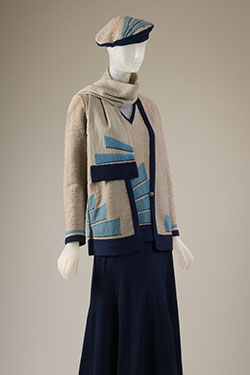
Ensemble, blue, gray, and turquoise wool knit and navy wool crepe, c. 1927, France,
Museum purchase.
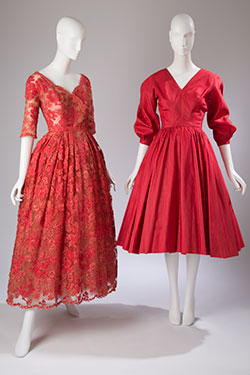
(left) Christian Dior, evening dress, red machine lace, red and white tulle, c. 1950,
France, gift of Nancy White, (right) Anne Fogarty, dress, red silk, c. 1954, USA,
unknown origin.
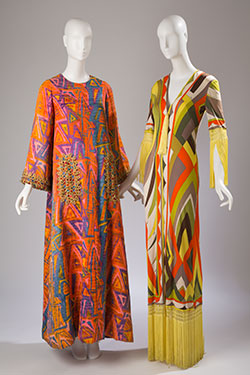
(left) Oscar de la Renta, caftan, multi colored caftan with beaded trim, c. 1963,
USA, gift of Diana Vreeland. (right) Emilio Pucci, dress, printed silk jersey, c.
1970, Italy, Gift of Robert Wells in Memory of Lisa Kirk.
During the 1920s, Jean Patou and Gabrielle Chanel designed chic, knit ensembles for
their French clients, thus ushering in a trend for knitwear. This relaxed material
was ideal for the new, active woman, who might be playing a round of tennis or walking
around the city, shopping. During the 1930s, glamorous, bias-cut dresses seen in both
Hollywood films and couture collections became a significant trend.
French couture came back full force after World War II with the silhouette launched by Christian Dior’s “New Look” collection. Well into the 1950s, New York-based designers such as Anne Fogarty continued to draw inspiration from Dior’s signature silhouette.
During the 1960s, the boom in commercial air travel enabled socialites, fashion photographers, and designers alike to visit far-off locations more easily than ever before. As a result, exoticism re-emerged. Brightly colored kaftans from Emilio Pucci and Oscar de la Renta became wardrobe essentials among the jet-set.
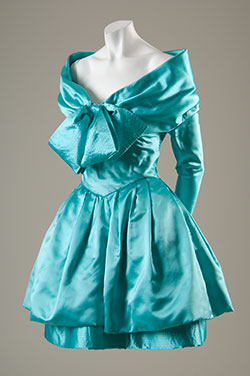
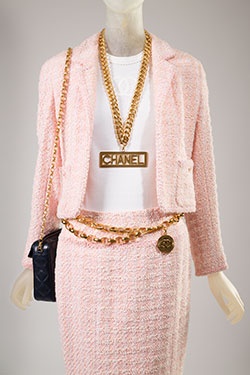
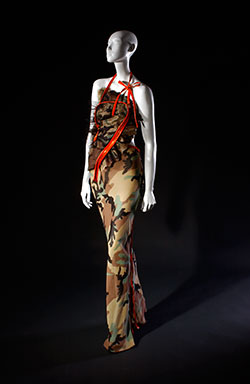
French couture came back full force after World War II with the silhouette launched by Christian Dior’s “New Look” collection. Well into the 1950s, New York-based designers such as Anne Fogarty continued to draw inspiration from Dior’s signature silhouette.
During the 1960s, the boom in commercial air travel enabled socialites, fashion photographers, and designers alike to visit far-off locations more easily than ever before. As a result, exoticism re-emerged. Brightly colored kaftans from Emilio Pucci and Oscar de la Renta became wardrobe essentials among the jet-set.

Christian Lacroix, evening dress, turquoise silk satin, c. 1988, gift of Mrs. Martin
D. Gruss.

Chanel (Karl Lagerfeld), suit, pink wool and synthetic blend, white cotton, spring
1994, France, gift of Chanel Inc.
Chanel (Karl Lagerfeld), necklace, gold plated metal, fall 1991, France, Gift of Depuis 1924.
Chanel (Karl Lagerfeld), necklace, gold plated metal, fall 1991, France, Gift of Depuis 1924.

Christian Dior (John Galliano), evening dress, camouflage print silk, spring 2001,
France, Museum purchase.
Throughout the 20th century, music inspired fashion. During the 1970s, Halston’s slinky
silk jersey designs filled the dance floors of Studio 54; twenty years later, hip-hop
artists such as Run DMC and Salt-N-Pepa inspired Karl Lagerfeld’s 1991 Chanel collection.
A particularly dramatic example is his version of the gold “dookie” chain, which he
festooned over an iconic Chanel wool suit.
As we move further into the 20th century, fashion trends emerge and spread in faster and more complex ways than ever before. The advent of fast-fashion, the internet, and social media has expanded the global environment. The dynamic pace of the current trend cycle has led the New York Times to ask, “Freedom of Choice: Are Trends Passé?” However, fashion forecasting companies have made researching and predicting trends a profitable business, proving that distinct styles continue to emerge and fade. Fashion designer Jean Paul Gaultier aptly points out that “designers are the catalysts of their time; their role is to translate the changes, the mutations, the evolution of society.” As culture continues to evolve, so, too, do trends in fashion.
As we move further into the 20th century, fashion trends emerge and spread in faster and more complex ways than ever before. The advent of fast-fashion, the internet, and social media has expanded the global environment. The dynamic pace of the current trend cycle has led the New York Times to ask, “Freedom of Choice: Are Trends Passé?” However, fashion forecasting companies have made researching and predicting trends a profitable business, proving that distinct styles continue to emerge and fade. Fashion designer Jean Paul Gaultier aptly points out that “designers are the catalysts of their time; their role is to translate the changes, the mutations, the evolution of society.” As culture continues to evolve, so, too, do trends in fashion.
Trend-ology was organized by Emma McClendon and Ariele Elia.
For more info about the exhibition, read the press release.
For more info about the exhibition, read the press release.


